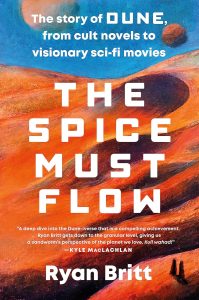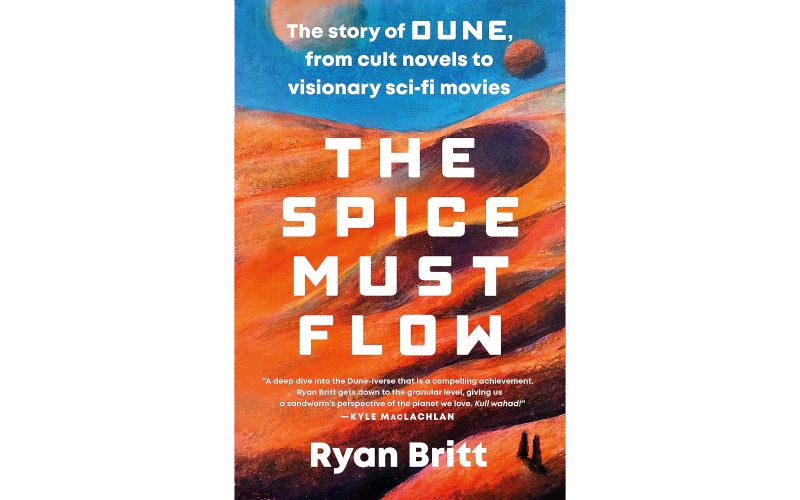In The Spice Must Flow: The Story of Dune, from Cult Novels to Visionary Sci-Fi Movies (2023), Ryan Britt has written an engaging and entertaining history of Frank Herbert’s Dune and the winding road it has taken to become a pop culture fixture. Its clever chapter titles and charming tone make for an enjoyable read. Weaving interviews with analysis and humorous commentary, Britt brings together a wide range of materials to explore the history of Dune, and he manages to make the feat look effortless!
Thirteen chapters cover the different stages in the life of this famous science fiction story, from its origins in Frank Herbert’s imagination to the new adaptation and beyond. There are fun tidbits about things such as how Duke Leto and Lady Jessica emerged from characters that had been more dull in Herbert’s earlier drafts, the importance of cover art to audiences, and what George Lucas thought about spice in Star Wars. Insightful lines include “Just because something was a science fiction movie, crafted by an auteur, and possessed striking (or goofy) production design does not mean that movie was good” (pg 119)—is this a reference to the unmade Alejandro Jodorowsky project, the David Lynch film, or something else? You’ll have to find out!
A clear fan of science fiction more broadly, Britt leverages his knowledge to pop in references to other media and draw connections between various points that readers may not have made themselves. He brings a contemporary perspective to the story and isn’t afraid to call things out when necessary. His strong and personable writer’s voice—especially in some cheeky footnotes—breathes life into the story, even when the facts are familiar.
As the second of mass market book on the topic of Dune to come out this month, Britt’s work shares some commonalities with Max Evry’s new book A Masterpiece in Disarray: David Lynch’s Dune: An Oral History focused specifically on the 1984 Lynch film adaptation, including information about the production and interviews with director Denis Villeneuve and leading actor Timothée Chalamet. However, Britt’s is a distinctly different book with a broader sweep, so the two books can be enjoyed one after the other.
What’s Inside
In the first chapter, Britt discusses the development of Herbert’s ecological consciousness and unpacks the myths that have built up around Herbert’s original goal in writing Dune. Chapter 2 focuses on the influence of Herbert’s spouse, Beverly, and how women are depicted in the novel. Full disclosure: I am quoted in this chapter about my scholarly work on the women in Dune so it was a highlight of Britt’s book for me—I very much appreciate that he gave this topic the attention it deserves, given the choice of so many other topics related to Dune.
The next few chapters cover the story of how Dune found a home as a serialized story in the science fiction magazine Analog, helmed by editor John W. Campbell, and then as a hardback and paperback by Chilton and Ace, respectively. Britt touches on some points that the scholarly community will appreciate about how Dune can be considered a bridge between the old guard of science fiction and the New Wave of the 1960s and ‘70s. He also raises a very interesting idea about the first edition hardback cover avoiding the stereotypical look of science fiction—rather than have sandworms or spaceships, it uses John Schoenherr’s original illustration of two figures in a canyon.
Chapters 5 through 7 are about the sequel, Dune Messiah, the early attempts at adapting Dune to the screen, and Children of Dune. Britt takes us through how Herbert’s story of Paul’s downfall wasn’t accepted by Campbell and instead had to find a home in another magazine, Galaxy, before becoming a book that confused people for being so different from Dune. The discussion of the early attempts on Dune includes an examination of Alejandro Jodorowsky’s proposed take on the story, and the impact that this never-made project had on the larger science fiction media landscape, notably the development of Ridley Scott’s Alien. Britt uncovers the real hero who helped make Children of Dune the first science fiction hardcover to become a New York Times bestseller—Herbert’s editor at Putnam, David Hartwell.
Following a multi-page color insert with photos of letters, book covers, and screen adaptations, Chapters 8 and 9 tackle the big topics of Star Wars and David Lynch’s 1984 film adaptation, Dune. Like Max Evry in his book on Lynch’s film, Britt mixes background information with interviews with some of the cast for this section and comes to the conclusion that although it might have been ahead of its time in the science fiction media landscape, it paved the way for other pieces of art.
Chapter 10 moves into Herbert’s last decade of life and his relationship with his third spouse, Theresa Shackleford, who it turned out didn’t have an interest in science fiction, Dune, or Herbert before she was hired to be a publicist for Herbert’s book tour for Heretics of Dune. They went to the premiere of Lynch’s film in Washington, DC, and lived in LA for a time but had only a brief period together before Herbert was diagnosed with cancer and passed away in 1986. Once again, Britt highlights the role of women in Herbert’s life, and provides insightful commentary from Shackleford on how Herbert thought highly of women and thought they should be running everything.
The final few chapters discuss John Harrison’s miniseries—Frank Herbert’s Dune and Children of Dune—and Denis Villeneuve’s new films, as well as the continuation novels by Herbert’s son, Brian Herbert, and co-writer Kevin J. Anderson. Britt touches on to what degree these works address the themes in Herbert’s original stories. He also includes interviews with Harrison and Villeneuve that give insights into how they thought about the book and the process of adaptation.
Britt closes the book with a discussion of Dune’s role as an environmental wake-up call able to speak to current and future generations, its handling of white savior tropes, and the power in the Litany Against Fear as a way to cope with the challenges we face. He ends with an epilogue that mentions how Dune shows up in all sorts of fun places in pop culture and will continue to live on because it’s fun and adventurous while also having layers of deeper meanings.
Final Thoughts
 Britt’s book represents a historic moment for publishing about Dune the novel and its cultural impact, becoming one of two mass market books on this broad topic (Tom Huddleston’s The Worlds of Dune: The Places and Cultures that Inspired Frank Herbert has the same release date; Max Evry’s book focuses primarily on the Lynch film adaptation). To date, there have been several academic books on the novel (including my two) and biographies of Herbert mixed with analyses of the novel, but no broad-spanning history of the epic story and how it has surfaced across the decades. The way Britt has made all of the material accessible and relevant while still grounding it in sources is admirable, and for scholars and anyone interested in diving deeper, Britt helpfully includes a list of source notes organized by chapter at the back.
Britt’s book represents a historic moment for publishing about Dune the novel and its cultural impact, becoming one of two mass market books on this broad topic (Tom Huddleston’s The Worlds of Dune: The Places and Cultures that Inspired Frank Herbert has the same release date; Max Evry’s book focuses primarily on the Lynch film adaptation). To date, there have been several academic books on the novel (including my two) and biographies of Herbert mixed with analyses of the novel, but no broad-spanning history of the epic story and how it has surfaced across the decades. The way Britt has made all of the material accessible and relevant while still grounding it in sources is admirable, and for scholars and anyone interested in diving deeper, Britt helpfully includes a list of source notes organized by chapter at the back.
With the new film adaptation by Villeneuve re-awakening interest in Dune, Britt offers an entertaining and insightful look at the history and possible future of this still-relevant novel and its offshoots. Britt’s book will appeal to a wide range of audiences, from devoted fans of the novel to those who have just heard about it enough to be curious what the big deal is. Hopefully this convinces them it’s a must-read that’s still going strong!
You can find The Spice Must Flow: The Story of Dune, from Cult Novels to Visionary Sci-Fi Movies on Amazon. Thanks to Britt for providing me an advanced copy as a thank you for doing an interview with him.
Note that some links on posts are affiliate links so I may earn a commission if you use them to complete a purchase.


